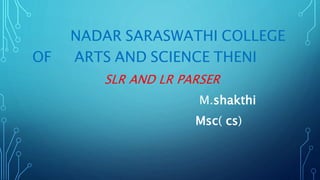CD
- 1. NADAR SARASWATHI COLLEGE OF ARTS AND SCIENCE THENI SLR AND LR PARSER M.shakthi Msc( cs)
- 2. SLR PARSER: ŌĆóThe SLR parser is simple to LR. ŌĆóItŌĆÖs the smaller class of grammer having few number of states. ŌĆóSLR is very easy to construct and is similar to LR parser .
- 3. ŌĆóThe only difference between SLR parser and LR parser is that in LR parsering table . ŌĆóThere is a change of 'SHIFT REDUCEDŌĆÖ conflict because we are entering ŌĆśreducedŌĆÖ corresponding to all terminal states. TYPES OF LR PARSERING METHODS: 1.SLR 2.CLR 3.LALR
- 4. STEPS FOR CONSTRUCTING SLR PARSERING TABLE: 1.writing arguments grammer. 2.LR(O) collection of items to be found. 3.Find FOLLOW of LHS of production. 4.Defining 2 function: GOTO( list of terminal) ACTION(list of non terminal)
- 5. EXAMPLE STEP1: SŌĆö>AA A-’āĀaA/b SŌĆÖ-’āĀS(0th production) S-’āĀ.AA(1st production) A-’āĀ.aA(2nd production) A-’āĀ.b(3rd production )
- 6. STEP2:
- 7. STEP3: Find follow of LHS of production FOLLOW (s)=┼× To find FOLLOW of non terminal.
- 8. STEP4: Definiting 2 function Goto, action.
- 9. LR PARSER: ItŌĆÖs an efficient bottom up syntax analysis techniques that can be used to parser language classes of context free grammar is called LR(O) parsing. L stands for left to right scanning R stands for rightmost derivation in reverse. O stands for no of input symbols of looahead.
- 10. THANK YOU









